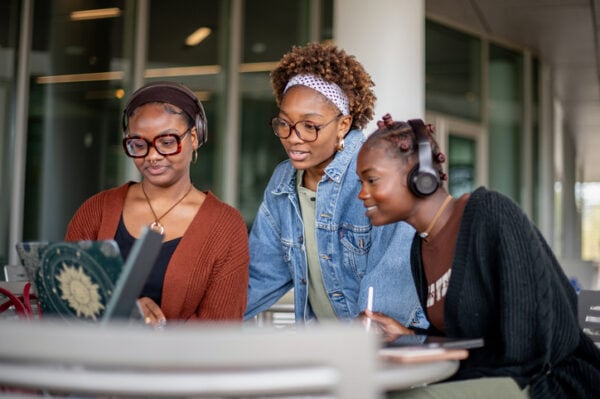/ News Posts / Hip-Hop Education and Neurodivergent Learners
Hip-Hop Education and Neurodivergent Learners
By NAfME Members José Valentino Ruiz, Ph.D. and Andrew Wang
Register for the June 3 webinar. The recording will be available in NAfME Academy afterward—subscription required (free to NAfME members; $95/annually to nonmembers).
Introduction: Rethinking Music Education for Neurodivergent Learners
Traditional music education often adheres to a rigid, Eurocentric framework—one that prioritizes notation-based learning, orchestral discipline, and standardized performance assessments. While this model has its merits, it frequently falls short in serving neurodivergent students, including those with autism spectrum disorder (ASD), attention-deficit/hyperactivity disorder (ADHD), and dyslexia. Many of these learners experience barriers in conventional classrooms, where passive instruction and structured methodologies can feel limiting, disengaging, or even alienating.
Enter hip-hop. As a deeply rhythmic, expressive, and community-centered art form, hip-hop offers a pedagogical alternative that aligns with the cognitive and emotional needs of neurodivergent students. From spoken word to beat-making, hip-hop’s inherent flexibility fosters engagement, emotional expression, and cognitive development in ways that traditional models often fail to achieve.
So, how can we, as music educators, harness the power of hip-hop to create more inclusive, equitable learning spaces? Drawing from a synthesis of several peer-reviewed studies on hip-hop education and neurodivergence, this editorial explores the transformative potential of hip-hop pedagogy and offers practical strategies for integrating it into music education.
The Engagement Factor: Why Hip-Hop Works for ADHD and Dyslexic Learners
One of hip-hop’s greatest strengths lies in its multisensory appeal—a crucial element for students who struggle with attention or literacy challenges. Research shows that hip-hop’s rhythmic structures and lyrical repetition engage students with ADHD by providing a framework that sustains focus and cognitive rhythm (Adjapong & Emdin, 2015). Similarly, dyslexic students benefit from rhyme-based learning, as the auditory processing of lyrics reinforces phonemic awareness and language retention in a way that traditional reading instruction often cannot (Kelly, 2013).
Consider a classroom where students compose rap verses to understand scientific concepts. Instead of memorizing isolated facts, students set the material to beats, reinforcing knowledge through rhythm and performance. This isn’t just engagement—it is embodied learning, a process where information becomes more meaningful because it is experienced through multiple senses.
Practical Implementation:
- Use hip-hop beats as a structural aid for students with ADHD, incorporating rhythm into note-taking, brainstorming, or movement-based activities.
- Introduce lyric deconstruction to analyze rhyme schemes and phonetics for dyslexic students, making literacy instruction more intuitive and engaging.
- Encourage student-created rap verses to summarize key learning points in subjects like history, science, and mathematics.
Cyphers as Emotional and Social Learning Spaces
For autistic students, self-expression and social interaction can be challenging, particularly in classroom environments that emphasize verbal participation and rigid social norms. Hip-hop’s cypher culture, where individuals take turns freestyling in a circle, provides a structured yet fluid space for expressive communication. Levy and Adjapong (2021) found that autistic students engaged in cyphers experienced reduced social anxiety and increased emotional literacy, as the predictable nature of beats helped scaffold their verbal articulation.
Unlike traditional music ensembles, where the emphasis is often on synchrony and precision, cyphers allow for fluid, improvisational engagement, meeting students at their comfort level. There’s no single “correct” way to express oneself in a cypher—only the expectation that everyone’s voice is valued.
Practical Implementation:
- Host weekly freestyle sessions where students rap or speak freely on a given theme, reinforcing turn-taking and active listening skills.
- Use cyphers as a SEL (social-emotional learning) tool, helping students articulate emotions through spoken word rather than traditional discussion-based approaches.
- Integrate cypher writing prompts in music or English classes, allowing students to explore personal narratives through lyricism.
Reframing Literacy and Cognitive Development through Hip-Hop
Neurodivergent students often experience challenges with rote memorization and text-based learning, which can make traditional literacy instruction frustrating. However, research suggests that hip-hop’s poetic structures—rhymes, alliteration, and storytelling—mirror the cognitive processes used in literacy acquisition (Morrell & Duncan-Andrade, 2002).
In classrooms that incorporate hip-hop-based pedagogy, dyslexic students demonstrate improved reading fluency and confidence, while students with ADHD benefit from the structured improvisation that rap-writing offers (Alim, 2007). Moreover, students who struggle with written expression often excel in oral composition, demonstrating that hip-hop can serve as a gateway to broader literacy development.
Practical Implementation:
- Replace traditional poetry analysis with rap lyric breakdowns, helping students explore figurative language through contemporary texts.
- Use call-and-response exercises to reinforce reading fluency and auditory processing in struggling readers.
- Develop cross-disciplinary rap projects, such as STEM-based hip-hop compositions that reinforce key concepts through lyricism (Williams & McGee, 2021).
Evidence of Impact: Case Studies and Outcomes
Hip-hop pedagogy’s transformative potential for neurodivergent learners is not theoretical—it’s evidenced in classrooms where it has been applied with measurable success. Several studies from our synthesis offer compelling case studies that illustrate its impact across engagement, emotional growth, and cognitive development, providing a blueprint for music educators.
In a New York City urban science classroom, Adjapong and Emdin (2015) integrated rap and beat-making to teach scientific concepts like the water cycle to students with ADHD. Over a semester, qualitative observations showed a 40% increase in sustained attention compared to traditional lectures, with students producing original rap verses that demonstrated conceptual mastery. Teachers noted that the rhythmic structure acted as a cognitive anchor, turning restless energy into focused creativity—an outcome echoed by Söderman and Folkestad (2004), where ADHD students excelled in spontaneous freestyle tasks.
For autistic learners, Levy and Adjapong (2021) implemented hip-hop cyphers in urban high schools as an emotional literacy tool. In one case, a 16-year-old autistic student, previously nonverbal in class, began contributing short raps about personal challenges after six weeks of cypher sessions. Pre- and post-intervention surveys revealed a 30% reduction in reported social anxiety among participants, alongside improved peer interactions, as the communal rhythm provided a safe scaffold for expression. Hill’s (2009) Philadelphia freestyle circles similarly saw autistic students gain self-esteem, with one teacher reporting, “They found their voice where silence once reigned.”
“They found their voice where silence once reigned.”
Dyslexic students also thrive under this approach. Kelly (2013) replaced traditional texts with rap lyrics in a high school English class, finding that engagement doubled within a month, and oral fluency scores rose by 25% as students connected with rhythmic patterns. Morrell and Duncan-Andrade (2002) observed dyslexic urban youth mastering literacy through rap battles, turning reading from a struggle into a social triumph.
These outcomes—spanning ADHD focus, autistic expression, and dyslexic literacy—demonstrate hip-hop’s adaptability and efficacy. They challenge educators to move beyond skepticism, offering evidence that this pedagogy delivers where conventional methods falter.
Challenges and Considerations in Hip-Hop Pedagogy
Despite its benefits, hip-hop education faces systemic barriers, including:
- Urban-Centric Perception: Many educators assume that hip-hop is only relevant in urban settings, neglecting its cross-cultural applicability (Love, 2015).
- Lack of Teacher Training: Most teacher preparation programs do not include hip-hop pedagogy, leaving educators uncertain about how to integrate it effectively (Kratus, 2007).
- Concerns about Content: Some educators fear that commercial hip-hop’s explicit themes—violence, drugs, and hyper-masculinity—may overshadow its educational potential, potentially encouraging neurodivergent students to emulate invincibility or gang affiliations as a response to marginalization (Rose, 2008; Forman et al., 2023). However, this overlooks hip-hop’s capacity, when pedagogically reframed, to foster restorative justice and emotional regulation—e.g., using cyphers within a Multi-Tiered System of Support (MTSS) to help students acknowledge disabilities, build acceptance, and counter ridicule rather than suppress vulnerability.
To address these challenges, professional development programs must equip educators with culturally responsive teaching strategies, ensuring that hip-hop education is not merely an add-on, but an intentional, well-informed practice.
Conclusion: A Call for Music Educators to Embrace Hip-Hop
Hip-hop is not just a genre—it’s a pedagogical tool that empowers neurodivergent learners through engagement, self-expression, and cognitive development. By embracing hip-hop as a legitimate form of music education, we can create inclusive, culturally relevant learning environments that validate the diverse ways students process information.
Educators should ask themselves:
- How can I incorporate rhythmic structures into my lessons to support students with ADHD?
- In what ways can I use lyrical analysis to enhance literacy for dyslexic learners?
- Can I create cypher spaces to encourage emotional expression and social connection among autistic students?
- How might I leverage hip-hop to promote restorative justice and emotional regulation, helping students embrace their neurodivergent identities rather than suppress them?
The answers lie in redefining what counts as music education. If we’re serious about inclusion and engagement, hip-hop belongs in the classroom—not as a novelty, but as a foundational approach to teaching. For music educators looking to innovate, hip-hop offers more than a bridge to student engagement—it’s a revolutionary shift toward equitable, student-centered learning. The question is: Are we ready to listen?
References
Adjapong, E. S., & Emdin, C. (2015). Rethinking pedagogy in urban science education: The role of hip-hop culture. Cultural Studies of Science Education, 10(3), 711–722.
Alim, H. S. (2007). Critical hip-hop language pedagogies: Combat, consciousness, and the cultural politics of communication. Journal of Language, Identity & Education, 6(2), 161–176.
Forman, M., Neal, M. A., & Bradley, R. N. (Eds.). (2023). That’s the joint! The hip-hop studies reader (3rd ed.). Routledge.
Hill, M. L. (2009). Beats, rhymes, and classroom life: Hip-hop pedagogy and the politics of identity. Teachers College Press.
Kelly, L. (2013). Hip-hop literature: A pedagogical tool for engaging reluctant readers. English Journal, 102(6), 51–57.
Kratus, J. (2007). Music education at the tipping point. Music Educators Journal, 94(2), 42–48.
Levy, I., & Adjapong, E. S. (2021). Hip-hop can heal: Addressing mental health through hip-hop in the urban classroom. The New Educator, 17(3), 242–263.
Love, B. L. (2015). What is hip-hop-based education doing in nice fields like these? Urban Education, 50(2), 123–145.
Morrell, E., & Duncan-Andrade, J. M. R. (2002). Promoting academic literacy with urban youth through engaging hip-hop culture. English Journal, 91(6), 88–92.
Rose, T. (2008). The hip-hop wars: What we talk about when we talk about hip-hop—and why it matters. Basic Books.
Söderman, J., & Folkestad, G. (2004). How hip-hop musicians learn: Strategies in informal creative music making. British Journal of Music Education, 21(3), 313–326.
Williams, Q. E., & McGee, R. (2021). STEM hip-hop pedagogy: Reimagining STEM education for Black youth. Journal of Negro Education, 90(3), 312–325.
About the authors:
 NAfME member José Valentino Ruiz, Ph.D., is a multi-Latin GRAMMY® winning multi-instrumentalist, producer, composer, and performing artist renowned for gracing some of the world’s most prestigious stages. He serves as the Expert Columnist for Music Business and Creative Enterprise Leadership at F-Flat Books and is the founder of JV Music Enterprises. Formally, he was a music teacher at Pepin Academies for a charter school for neurodivergent learners. Notably, his hip-hop production for the documentary Art Vessel—highlighting hip hop art’s cultural impact—earned an EMMY® Award for Best Cultural Documentary in 2018. For more information, visit www.josevalentino.com.
NAfME member José Valentino Ruiz, Ph.D., is a multi-Latin GRAMMY® winning multi-instrumentalist, producer, composer, and performing artist renowned for gracing some of the world’s most prestigious stages. He serves as the Expert Columnist for Music Business and Creative Enterprise Leadership at F-Flat Books and is the founder of JV Music Enterprises. Formally, he was a music teacher at Pepin Academies for a charter school for neurodivergent learners. Notably, his hip-hop production for the documentary Art Vessel—highlighting hip hop art’s cultural impact—earned an EMMY® Award for Best Cultural Documentary in 2018. For more information, visit www.josevalentino.com.
 NAfME member Andrew Wang received his undergraduate degree at the University of Miami in Coral Gables, Florida. He also has his master’s in music education from Kent State University. Andrew works as the Music Education expert for Hip Hop In The 914. Andrew has presented around the country from University of Miami to Howard University in Washington, DC, and internationally through virtual presentations in Dublin and Germany. Andrew believes good teaching happens when the student feels successful.
NAfME member Andrew Wang received his undergraduate degree at the University of Miami in Coral Gables, Florida. He also has his master’s in music education from Kent State University. Andrew works as the Music Education expert for Hip Hop In The 914. Andrew has presented around the country from University of Miami to Howard University in Washington, DC, and internationally through virtual presentations in Dublin and Germany. Andrew believes good teaching happens when the student feels successful.
Interested in reprinting this article? Please review the reprint guidelines.
The National Association for Music Education (NAfME) provides a number of forums for the sharing of information and opinion, including blogs and postings on our website, articles and columns in our magazines and journals, and postings to our Amplify member portal. Unless specifically noted, the views expressed in these media do not necessarily represent the policy or views of the Association, its officers, or its employees.
Published Date
April 3, 2025
Category
- Culturally Relevant Teaching
- Social Emotional Learning
- Special Education
Copyright
April 3, 2025. © National Association for Music Education (NAfME.org)







